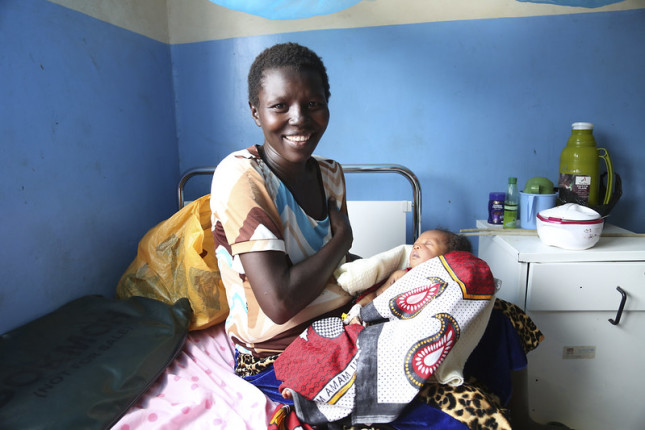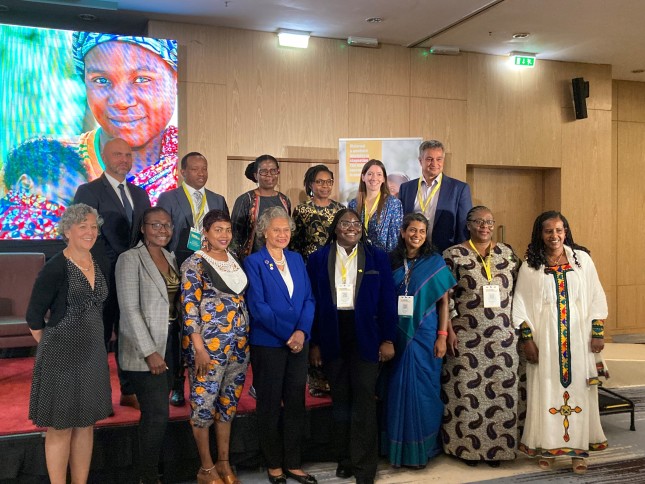-
Finding the Power to Prevent Maternal Deaths: Women Deliver 2023
August 16, 2023 By Deekshita Ramanarayanan
The 2023 Women Deliver Conference in Kigali, Rwanda offered participants an opportunity to think deeply about gender equality, and the urgency of this moment in making progress was evident – even at a pre-conference event hosted by the United Nations Population Fund (UNFPA): Scaling Up Actions to End Preventable Maternal Deaths: Linkages with Family Planning, Bodily Autonomy and the Health Workforce.
“This year marks the halfway point to achieve the 2030 global Sustainable Development Goals,” said Dr. Julitta Onabanjo, Director of the Technical Division at UNFPA. But she added that the global “polycrisis” of the past four to five years has created significant challenges. The overlap of the COVID-19 pandemic, climate disasters, local and national conflicts, and economic recessions have all further harmed groups already been left behind. Additionally, progress towards improving maternal and newborn health has stagnated or even worsened in some areas, said Dr. Onabanjo.
Working across sectors to ensure that issues such as maternal health and maternal mortality are being raised in more “non-traditional” sectors of development is essential. “There is no one singular solution to such complex problems,” said Dr. Samukeliso Dube, Executive Director of the global family planning partnership, FP2030.
Ann Starrs, Director for Family Planning at the Bill & Melinda Gates Foundation, argued that access to proven interventions is a challenging, but solvable, problem. She said that “we know what it takes to prevent these deaths. They’re preventable with access to contraception, to drugs and medications, and interventions to essential services.” We must make the case for why investing in women’s health, well-being, and economic power is valuable not only from a rights perspective, added Starrs, but for the good of societies as a whole.
Integrating Maternal Health Across the Health Sector and Beyond
Maternal and newborn health is often siloed within sexual and reproductive health and rights (SRHR), and across the development space more generally. Pascale Allotey, Director of the World Health Organization’s Department of Sexual and Reproductive Health & Research, noted that fragmentation within the movement can mean that advocates become “our own worst enemy.”
It is essential to present an integrated package of essential services, said Dr. Alvaro Bermejo, Director-General of the International Planned Parenthood Federation. Doing so will ensure that providers and clinics do not separate out and integrate only the parts of SRHR that they are more comfortable with. He also noted that any set of interventions must put women at the center and avoid the fragmentation of care that goes against comprehensive sexual and reproductive health (SRH) care.
Allotey added that such an approach would mean that SRHR should include maternal health, contraception, abortion care, infertility and fertility treatment, healthy sexuality, prevention and treatment of HIV and STIs, and prevention and response to gender-based violence. Taken together, these elements will form the basis of a dignified life for all, she said.
Maternal health, SRHR, and gender equality also must be incorporated into sectors where women are much more underrepresented. One such area is public debt. Asha George, Research Chair in Health Systems, Complexity, and Social Change at the University of the Western Cape in South Africa, spoke to the unseen impact of rising public debt on women and girls, particularly in the Global South. Since 2000, public debt in low- and middle-income countries has increased by five times. While high income countries actually carry more debt, low- and middle-income countries often pay more in total. For instance, African countries pay eleven times more in debt repayment than high-income countries do—and women and girls on the continent see the negative impact of the resulting budget cuts. George observed that “3.3 billion people live in countries where governments are spending more on interest than in education and health.”
Cameroon institutionalized a multisectoral approach encompassing maternal, newborn, and child health in 2014, hoping to reduce maternal deaths to 29 percent by 2020. Brenda Formin, who works with the Adolescent Sexual and Reproductive Health Exemplars (ASHER) project in the country, noted that the maternal death rate actually decreased by 40 percent over that period, reflecting the success of this approach. However, “there is still so much that needs to be done.” As much as health workers are trained to prevent maternal death, cross-sectoral funding and proper implementation of programs continues to fall short, she added.
“There are schisms in the movement at the moment,” said Victoria Spencer, SRHR Team Lead at the United Kingdom Foreign, Commonwealth, and Development Office. She urged a path forward that is more inclusive of young people, LGBTQ+ people, women and girls with disabilities, as well as other historically marginalized groups, in order to grow the SRHR movement.
Efforts at the donor level also must recognize the importance of integration of care at all levels. “Donors often play a key role in these more siloed approaches,” said Starrs. Donors must commit to ensuring that comprehensive sexual and reproductive health services are easily accessible and integrated into all sectors of the development sphere, without “shying away” from more controversial issues, she said.

Protecting Health Care Workers Globally
George observed that the health sector has a mandate to provide services for women. Yet while technical guidance for the health sector on providing SRH services has expanded in recent years, the lack of an enabling environment for health workers continues to add a strain to the sector. Health workers are predominantly women, for instance, but they experience pay inequity that ranks among the worst in global economies, with 24 percent of the existing wage gap attributed to gender. The health sector is “run by women, delivered by women, but led by men,” said George. In addition, structural issues across the sector have been exacerbated by the COVID-19 pandemic, and more recently, growing anti-SRHR movements.
“We cannot forget the security of the frontline healthcare providers,” added Dr. Bermejo. He noted that over the last year in particular, the enormous threat of violence experienced by health workers globally has skyrocketed—in part due to the growing anti-SRHR and anti-gender equality movements. Dr. Bermejo also observed that some providers are instructed to avoid carrying identifying information of their affiliations due to the risk of experiencing violence in more restrictive environments. Fellow health care providers have a duty to speak out when colleagues and clients face increasing violence on a daily basis, he added.
Health workers also must play a key role in countries with a difficult terrain that makes the inability to reach a health care center in time to deliver a major contributor to maternal death. Addiszemen Chanie Sewnet, a health worker overseeing maternal health programs in the Amhara Regional Health Bureau in Ethiopia, described how a health extension worker program was created to overcome the country’s mountainous terrain. This program provides a community level health worker who ensures that pregnant women can arrange transport to a maternity waiting home to deliver safely, fulfills duties within the community, and provides postpartum care.
Increasing recruitment and retention of health workers is also critical to ensuring the availability of providers to prevent maternal death. As the host country for the conference, Rwanda offers an example of how to do so. Dr. Hassan Sibomana, Division Manager for Maternal, Child, and Community Health at the Rwanda Ministry of Health, shared the nation’s ongoing work to increase recruitment of midwives working in the country. Through increased mentorship, opportunities for career advancement, and graduate programs for midwifery, Rwanda hopes to provide one midwife per health center across the country.
Political Will and the Legal Landscape
When it comes to taking global action to prevent maternal deaths and improving sexual and reproductive health and rights worldwide, Dr. Sibomana observed that “everything has to start from political will.” Throughout this pre-conference symposium, panelists spoke about the importance of policy-level change to improve maternal health outcomes globally. Yet they also cited growing challenges coming from anti-SRHR and anti-gender equality movements.
Progress has been made across SRHR since 2000, with more than 70 global policy changes expanding access to SRHR, including abortion care. However, global movements against gender equality have gained momentum in recent years. Pansi Mihowa-Katenga, Global Director for Development at Ipas, said that “we are not surprised to see this increased anti-rights movement growing to reverse the gains that have been achieved in the last few years.” She added that these movements are well-funded and well-organized. They also often enter SRHR spaces undetected, using misinformation to influence young women and girls who seek abortions and other SRHR services. This increases the fear and stigma these young women and girls feel in already restrictive environments.
Actions in the Global North, such as the U.S. Supreme Court’s Dobbs v. Jackson Women’s Health Organization decision that removed the constitutional right to abortion, leave countries receiving global health assistance concerned about its continuation to include comprehensive SRH services, or its continuation altogether. As a result, many countries fear taking action to expand SRHR, and leave space for anti-abortion and anti-gender movements to roll back progress made in the last two decades.
Panelists also pointed out that the solutions to improve maternal health—such as expanding access to contraception, expanding and empowering the health workforce, and integrating SRH across sectors—are fully achievable given sufficient support at the policy level. “It is not that we can’t prevent maternal deaths. It is that we have not decided that women’s lives are worth saving,” commented Dr. Dube.
Sources: Nigeria Health Watch, United Nations Conference on Trade and Development, Women Deliver, World Health Organization.
Photo Credit: A Kenyan woman and her newborn baby in a maternity ward. Credit: Russell Watkins/DFID. In-text photo: Speakers and panelists for the Women Deliver pre-conference hosted by UNFPA standing in front of stage. Credit: Maternal Health Initiative
 A Publication of the Stimson Center.
A Publication of the Stimson Center.




